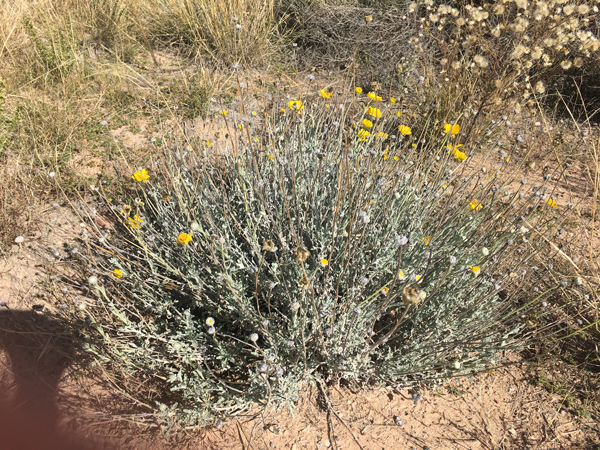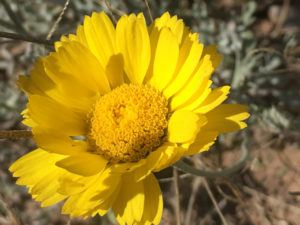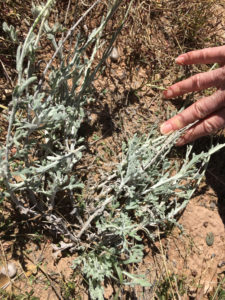Scientific name: Baileya multiradiata
Common names: desert marigold, showy desert marigold, paper daisy, desert Baileya
Family: Asteraceae
Article by Jeanne Gozigian
The one thing that you can be absolutely sure of in researching location and blooming periods of wildflowers, is that you can never be sure of any definitive conclusions!
Around 1991, a group of volunteer docents, under the direction of Viola Fisher, head docent extraordinaire of the newly signed lease/management agreement with El Rancho de las Golondrinas’s Leonora Curtin Wetland Preserve for the Santa Fe Botanical Garden, Santa Fe, New Mexico, to take on the task of documenting what plants were in the preserve, where they were located and when they flowered. It quickly became apparent in following seasons that plants jumped around the preserve and flowered at random times. My notes from the time listed desert marigold as flowering in May. I can’t remember listing it as blooming later in subsequent seasons.

Photo by Jeanne Gozigian.
Therefore, when I found numerous stands of bright yellow flowers blooming in early November all over the Rio Grande Bosque adjacent to my home north of Albuquerque, I assumed that they must be an Asteraceae species that I did not know. All of the other familiar autumn asters were long past peak blooming periods.

Photo by Jeanne Gozigian.
Research, my own photographs and consultation with my knowledgeable proofreaders finally convinced me that these were, indeed, desert marigolds, Baileya multiradiata. Baileya honors Jacob Whitman Bailey (1811-1857), a chemist and botanist known for pioneering the use of a microscope to study diatoms – microscopic single-cell organisms which are neither plant, animal or fungi. Multiradiata refers to blossoms with many ray flowers in each head. The meaning of the name is derived from the Anglo-Saxon. Merse-mear-gealla or marsh-horse-gowl were names for marigolds and marsh marigolds, specifically. Marigolds, generally, are derivatives of “Mary’s Gold”, in honor of the Virgin. B. multiradiata is only a remote relative to the true marigolds, genus Tagetes.
 Desert marigolds form dense patches of 12-18 inch tall mounds of naked stems, each topped with a daisy-like flower head. The silvery green foliage often has lobed leaves at the base of the stems, which I discovered on close examination of the plants, helping to cement my determination that I was correct in identifying the plants. I also discovered that they can have long blooming periods, i.e., into November. The blossoms of these short-lived perennial to annual plants have flower heads that turn papery with age, giving rise to one if its popular names, paper daisy.
Desert marigolds form dense patches of 12-18 inch tall mounds of naked stems, each topped with a daisy-like flower head. The silvery green foliage often has lobed leaves at the base of the stems, which I discovered on close examination of the plants, helping to cement my determination that I was correct in identifying the plants. I also discovered that they can have long blooming periods, i.e., into November. The blossoms of these short-lived perennial to annual plants have flower heads that turn papery with age, giving rise to one if its popular names, paper daisy.
To develop a wildflower area, seeds are available from American Meadows and Amazon.com. Natural reseeding is made easy by black-throated sparrows who eat the pale tan seeds in the fall. They do well in zones 3-10, in full sun, in dry, well-drained soil. Many wildflower enthusiasts like to subscribe medical properties to favorite plants; desert marigolds are no exception. Articles refer to “calendulas’ (a term interchangeable with marigold) as having healing and antiseptic properties if one makes infusions of the flower heads. They can also be useful as dyes and for food coloring – look at the bright yellow color! But, marigolds can be toxic to sheep and goats. Care must be taken, as with all natural remedies, when contemplating internal injestion.
Baileya multiriadiata is native to the Mexican states of Sonora, Chihuahua and Durango, among others, and, in the US, California, Arizona, Nevada, Utah, New Mexico and Texas.
Thanks to Janice Tucker and Helen Woody for proofreading this article.
Sources:
“Baileya multiriadiata”. Native Plants Database. Lady Bird Johnson Wildflower Center. 24 Feb. 2016. Web. 26 Feb. 2019. Retrieved from: https://www.wildflower.org/plants/result.php?id_plant=bamu
“Baileya multiriadiata”. Wikipedia. Wikimedia Foundation. 14 Feb. 2018. Web. 26 Feb. 2019. Retrieved from: https://en.wikipedia.org/wiki/Baileya_multiradiata
“Desert Marigold Seeds”. American Meadows. Web. 26 Feb. 2019. Retrieved from: https://www.americanmeadows.com/desert-marigold-seeds
Gozigian, Jeanne T. Notebook documenting blooming times and location of plants in the Leonora Curtin Wetland Preserve (then Leonora Curtin natural History Area). Santa Fe, New Mexico, May 1991.
“Medical Uses of Marigolds”. Off the Grid News. Web. 26 Feb. 2019. Retrieved from: https://www.offthegridnews.com/alternative-health/medicinal-uses-of-marigolds
Williams, David B. “Desert Marigold”. DesertUSA.com. Web. 26 Feb. 2019. Retrieved from: https://www.desertusa.com/flowers/desert-marigold.html


